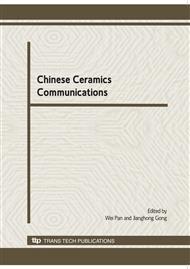p.750
p.754
p.758
p.761
p.765
p.769
p.773
p.778
p.782
Effect of Carbon as Foaming Agent on Pore Structure of Foam Glass
Abstract:
Insulation effect and mechanical performance of foam glass depend, to a large extent, on foam structure. Hence understanding foam formation is not only a problem of significant fundamental interest but also of tremendous practical impact. In this paper, foam growth was modeled comparing to grain growth theory in sintering. TG-DTG analysis of carbon black indicated that pre-oxidation took place prior to foaming temperature. Furthermore effects of heating rate and particle size of carbon black on foam structure have been taken into account. Several borosilicate foam glasses were fabricated by powder sintering process at different heating rates using carbon black of different particle sizes as foaming agent, respectively. It was found that increasing the heating rate tended to decrease the pre-oxidation of carbon black resulting in inhomogeneous foam distribution. Foam structure of sample heated at a rate of 8°C/min using carbon black with particle size of 0.15mm was optimal.
Info:
Periodical:
Pages:
765-768
Citation:
Online since:
April 2010
Authors:
Keywords:
Price:
Сopyright:
© 2010 Trans Tech Publications Ltd. All Rights Reserved
Share:
Citation:


